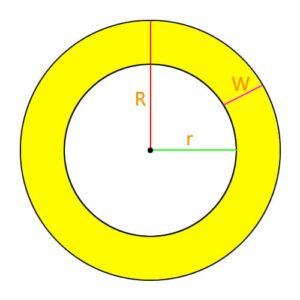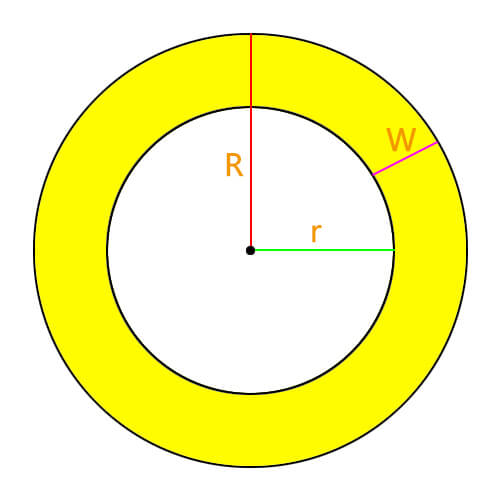The Annulus Calculator is your compass through the complexities of annular shapes. Specifically designed to calculate the width, perimeter, and area of an annulus, this tool empowers students, enthusiasts, and professionals with seamless geometric insights.
What is an Annular
 An annulus, often referred to as a ring, is a two-dimensional shape consisting of two concentric circles. Understanding and working with annuli (plural of annulus) involves mastering its key parameters: width, perimeter, and area. The Annulus Calculator becomes invaluable in swiftly computing these values.
An annulus, often referred to as a ring, is a two-dimensional shape consisting of two concentric circles. Understanding and working with annuli (plural of annulus) involves mastering its key parameters: width, perimeter, and area. The Annulus Calculator becomes invaluable in swiftly computing these values.
How to Calculate
Let’s delve into the step-by-step instructions for calculating the width, perimeter, and area of an annulus:
Width of an Annulus
The width of an annulus refers to the distance between the outer and inner circles. It is essentially the measure of the space between the concentric circles that form the annular shape. To calculate the width, you subtract the radius of the inner circle (r) from the radius of the outer circle (R), and the result represents the width (W):
W = R – r
For example, if the outer radius is 10 units and the inner radius is 6 units, the width would be
W = R – r = 10 – 6 = 4 units
Perimeter of an Annulus
The perimeter of an annulus is the total length of the outer and inner boundaries. In other words, it is the sum of the lengths of the outer and inner circumferences of the concentric circles. The formula for calculating the perimeter (P) involves using the radii of both circles:
P = 2π (R + r)
Here, π is the mathematical constant pi (approximately 3.14159), and R and r represent the radii of the outer and inner circles, respectively.
Example: If the outer radius is 15 units and the inner radius is 12 units, the perimeter is
P = 2π (R + r) = 2π * (15 + 12) = 169.646 units
Area of an Annulus
The area of an annulus is the total space enclosed between the outer and inner circles. It represents the region that is not occupied by the inner circle within the outer circle. The formula for calculating the area (A) involves subtracting the area of the inner circle from the area of the outer circle:
A = π(R2 – r2)
Here, π is again the mathematical constant pi, and R and r represent the radii of the outer and inner circles, respectively.
Example: If the outer radius is 8 units and the inner radius is 5 units, the area is
A = π (R2 – r2) = π( 82 – 52) = 122.522 square units
FAQs
- Q: How do I interpret the width practically when dealing with physical objects?A: The width represents the space between the concentric circles, crucial for applications like framing and design.
- Q: Can the Annulus Calculator handle decimal values for radii?A: Absolutely! The calculator accommodates both whole numbers and decimal values for precise calculations.
- Q: Is there a restriction on the unit of measurement for radii?A: No, the calculator is unit-agnostic, allowing the input of radii in any consistent unit of measurement.
- Q: What happens if the larger radius is smaller than the smaller radius?A: The calculator will handle this internally, placing the larger radius outside the smaller radius.
- Q: How does rounding work in the final output?A: The calculator retains up to 6 decimal places.
- Q: Can the Annulus Calculator differentiate between width, perimeter, and area?A: Yes, the calculator distinctly calculates each parameter, offering a comprehensive understanding of the annulus geometry.
- Q: How user-friendly is the calculator for beginners?A: The Annulus Calculator is designed with user-friendliness in mind, offering a straightforward interface suitable for beginners. Just enter the outer and inner radius.
- Q: Does the Annulus Calculator store or track user data?A: No, the calculator is developed with user privacy in mind and does not store or track any user data.
Latest Calculators
Standard Form to Slope-Intercept Form Calculator
Slope Intercept Form Calculator
Slope Calculator: Calculate Slope, X-Intercept, Y-Intercept
Reciprocal of Complex Number Calculator
Conjugate Complex Number Calculator
Modulus of Complex Number Calculator
Profit Percentage Calculator: Calculate Your Profitability Easily
Attendance and Absence Percentage Calculator
Trigonometric Functions
Arccsc Calculator – Find the Exact Value of Inverse Cosecant
Arcsec Calculator – Find the Exact Value of Inverse Secant
Arccot Calculator – Find the Exact Value of Inverse Cotangent
Arctan Calculator – Find the Exact Value of Inverse Tangent
Inverse Cosine Calculator – Find The Exact Value of Arccos
Inverse Sine Calculator – Find The Exact Value of Arcsin
Inverse Trigonometric Functions Calculator
Trigonometric Functions Conversion Calculator
Trig Calculator – Find 6 Trigonometric Functions by Angles or Sides
